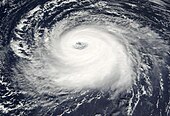
Back Tropiese sikloon Afrikaans Tropischer Wirbelsturm ALS Ciclón tropical AN उष्णकटिबंधी चक्रबात ANP إعصار استوائي Arabic Ciclón tropical AST Tropik siklon Azerbaijani تروپیک سیکلون AZB Тропик циклон Bashkir Tropischa Wiabeschtuam BAR

| Part of a series on |
| Tropical cyclones |
|---|
 |
|
Outline Media coverage |
A tropical cyclone is a rapidly rotating storm system with a low-pressure area, a closed low-level atmospheric circulation, strong winds, and a spiral arrangement of thunderstorms that produce heavy rain and squalls. Depending on its location and strength, a tropical cyclone is called a hurricane (/ˈhʌrɪkən, -keɪn/), typhoon (/taɪˈfuːn/), tropical storm, cyclonic storm, tropical depression, or simply cyclone. A hurricane is a strong tropical cyclone that occurs in the Atlantic Ocean or northeastern Pacific Ocean. A typhoon occurs in the northwestern Pacific Ocean. In the Indian Ocean and South Pacific, comparable storms are referred to as "tropical cyclones". In modern times, on average around 80 to 90 named tropical cyclones form each year around the world, over half of which develop hurricane-force winds of 65 kn (120 km/h; 75 mph) or more.[1]
Tropical cyclones typically form over large bodies of relatively warm water. They derive their energy through the evaporation of water from the ocean surface, which ultimately condenses into clouds and rain when moist air rises and cools to saturation. This energy source differs from that of mid-latitude cyclonic storms, such as nor'easters and European windstorms, which are powered primarily by horizontal temperature contrasts. Tropical cyclones are typically between 100 and 2,000 km (62 and 1,243 mi) in diameter. The strong rotating winds of a tropical cyclone are a result of the conservation of angular momentum imparted by the Earth's rotation as air flows inwards toward the axis of rotation. As a result, cyclones rarely form within 5° of the equator. Tropical cyclones are very rare in the South Atlantic (although occasional examples do occur) due to consistently strong wind shear and a weak Intertropical Convergence Zone. In contrast, the African easterly jet and areas of atmospheric instability give rise to cyclones in the Atlantic Ocean and Caribbean Sea.
Heat energy from the ocean acts as the accelerator for tropical cyclones. This causes inland regions to suffer far less damage from cyclones than coastal regions, although the impacts of flooding are felt across the board. Coastal damage may be caused by strong winds and rain, high waves (due to winds), storm surges (due to wind and severe pressure changes), and the potential of spawning tornadoes. Climate change affects tropical cyclones in several ways. Scientists found that climate change can exacerbate the impact of tropical cyclones by increasing their duration, occurrence, and intensity due to the warming of ocean waters and intensification of the water cycle.[2][3] Tropical cyclones draw in air from a large area and concentrate the water content of that air into precipitation over a much smaller area. This replenishing of moisture-bearing air after rain may cause multi-hour or multi-day extremely heavy rain up to 40 km (25 mi) from the coastline, far beyond the amount of water that the local atmosphere holds at any one time. This in turn can lead to river flooding, overland flooding, and a general overwhelming of local water control structures across a large area.
- ^ Global Guide to Tropical Cyclone Forecasting: 2017 (PDF) (Report). World Meteorological Organization. April 17, 2018. Archived (PDF) from the original on July 14, 2019. Retrieved September 6, 2020.
- ^ Knutson, Thomas; Camargo, Suzana J.; Chan, Johnny C. L.; Emanuel, Kerry; Ho, Chang-Hoi; Kossin, James; Mohapatra, Mrutyunjay; Satoh, Masaki; Sugi, Masato; Walsh, Kevin; Wu, Liguang (August 6, 2019). "Tropical Cyclones and Climate Change Assessment: Part II. Projected Response to Anthropogenic Warming". Bulletin of the American Meteorological Society. 101 (3): BAMS–D–18–0194.1. Bibcode:2020BAMS..101E.303K. doi:10.1175/BAMS-D-18-0194.1. hdl:1721.1/124705. ISSN 0003-0007.
- ^ "Major tropical cyclones have become '15% more likely' over past 40 years". Carbon Brief. May 18, 2020. Archived from the original on August 8, 2020. Retrieved August 31, 2020.